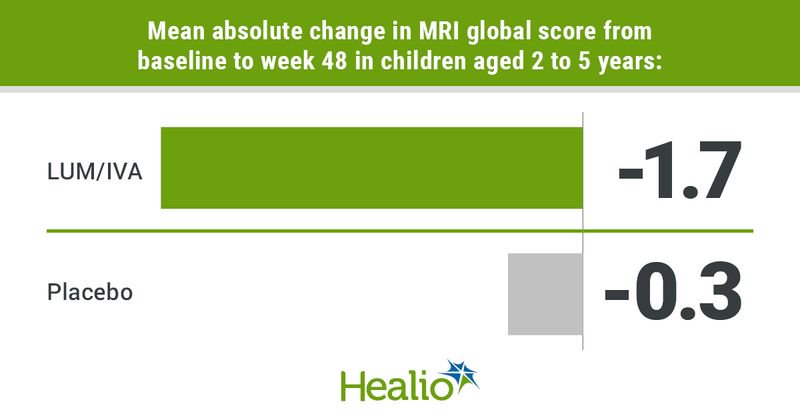Combination therapy yields improvements in pediatric cystic fibrosis
Key takeaways:
- Kids aged 2 to 5 years receiving cystic fibrosis dual therapy vs. placebo showed improved MRI global chest score.
- This combination also led to improved lung clearance index and growth parameters.
Lumacaftor/ivacaftor showed various improvements in kids aged 2 to 5 years homozygous for F508del-CFTR over 48 weeks, according to study results published in Annals of the American Thoracic Society.

“In our study on the efficacy of lumacaftor-ivacaftor to change the course of early CF lung disease in preschool children, we were able to demonstrate that this treatment leads to an improvement in structural lung disease by means of the MRI global score,” Mirjam Stahl, MD, head of the division of cystic fibrosis at Charité – Universitätsmedizin in Berlin, Germany, told Healio. “As this was the first randomized controlled trial on CFTR modulators in that age group using MRI as primary endpoint, we were happy to find that this method is able to capture this treatment effect even in children with age-dependent mild to moderate CF lung disease.”

As Healio previously reported, this combination therapy was generally safe and well-tolerated in pediatric patients aged 2 to 5 years homozygous for the F508del-CFTR mutation over 24 weeks.
Lumacaftor/ivacaftor (LUM/IVA) has also shown similar results in children aged 1 year to younger than 2 years with the same mutation over 24 weeks.
In this randomized, double-blind, placebo-controlled phase 2 study, Stahl and colleagues analyzed 51 children aged 2 to 5 years with cystic fibrosis to determine how treatment with LUM/IVA changes chest MRI global score over a total of 48 weeks compared with a placebo.
Researchers divided their study into two parts, and this study captures findings from the first part. In part one, 35 children (mean age 3 years, 88.6%; 68.6% boys) received LUM/IVA, and 16 (mean age 3 years, 93.8%; 56.3% boys) received placebo for 48 weeks. In part B, the total cohort will be given the combination therapy for 48 more weeks.
In addition to changes in chest MRI global score evaluated through Bayesian methods, researchers assessed absolute changes in lung clearance index2.5 (LCI2.5), z scores for weight-for-age, stature-for-age and BMI-for age, sweat chloride concentration and pancreatic function biomarkers levels of fecal elastase-1, serum immunoreactive trypsinogen and fecal calprotectin from baseline to the end of the study period.
Researchers determined the dosing of the combination therapy according to whether the child weighed less than 14 kg (100 mg LUM/125 mg IVA) or 14 kg or more (150 mg LUM/188 mg IVA). LUM/IVA and placebo doses were given every 12 hours.
Primary endpoint
An adverse event in one child before receiving LUM/IVA led to discontinuation, and an additional child discontinued the dual therapy because they began treatment with the commercially available drug.
Since a negative value in terms of MRI global score signals improvement, researchers found that LUM/IVA showed more improvement by the end of the study period than placebo (mean absolute change, –1.7 vs. –0.3; difference, –1.5; 95% CI, –5.5 to 2.6). The combination therapy also demonstrated better Bayesian posterior probability (76%).
More specifically, LUM/IVA showed larger declines in four out of the seven factors used to figure out the total MRI global score than the placebo. The difference shown was –0.2 (95% CI, –0.7 to 0.3) in consolidations, –0.3 (95% CI, –1.7 to 1.1) in mosaic pattern, –0.2 (95% CI, –1.4 to 1) in mucus plugging and –1.2 (95% CI, –2.7 to 0.4) in perfusion abnormalities.
Secondary endpoints
When evaluating the mean absolute change in LCI2.5, which was measured with a multiple-breath washout device, researchers found that patients receiving the combination therapy had lower LCI2.5 by week 48 than patients receiving placebo (–0.37; 95% CI, –0.85 to 0.1 vs. 0.32; 95% CI, –0.2 to 0.84).
By the end of the study period, Stahl and colleagues also observed improvements in growth parameters with LUM/IVA rather than placebo in weight-for-age z score (mean absolute change, 0.13; 95% CI, –0.01 to 0.27 vs. –0.07; 95% CI, –0.24 to 0.11), stature-for-age z score (mean absolute change, 0.09; 95% CI, –0.05 to 0.22 vs. 0.1; 95% CI, –0.04 to 0.24) and BMI-for-age z score (mean absolute change, 0.2; 95% CI, –0.2 to 0.41 vs. –0.24; 95% CI, –0.55 to 0.07).
When evaluating the mean absolute change in sweat chloride concentration from baseline to week 48, researchers found a larger decline in those taking LUM/IVA (–25.4 mmol/L; 95% CI, –32 to –18.8 mmol/L) than placebo (1 mmol/L; 95% CI, –4.5 to 6.6).
Researchers additionally reported that LUM/IVA patients had more improvements in the studied pancreatic function biomarkers than placebo patients by the end of the study period. They observed that LUM/IVA demonstrated a greater increase in fecal elastase-1 (mean absolute change, 37.1 µg/g vs. 2.6 µg/g), greater decrease in immunoreactive trypsinogen (mean absolute change, –85.5 ng/mL vs. –37.9 ng/mL) and a greater decrease in fecal calprotectin (mean absolute change, –133.9 µg/g vs. 26.14 µg/g).
Safety
Adverse events occurred in every child; however, 28.6% of these events were classified as mild and 68.6% were classified as moderate in those receiving LUM/IVA. Additionally, these events were “unlikely or not related to study drug,” the researchers wrote.
In patients taking LUM/IVA, nasopharyngitis (n = 22) was the most frequent adverse event, followed by infective pulmonary exacerbation of CF (n = 16), cough (n = 10), rhinitis (n = 9), abdominal pain (n = 7) and pyrexia (n = 6).
Among those receiving combination therapy, 20% had a serious adverse event, which was more than the 12.5% of patients receiving placebo; however, researchers deemed that these events aligned with CF in this age range of children and most likely were not connected to LUM/IVA.
Lastly, compared with those in the placebo group, those in the LUM/IVA group experienced more pulmonary exacerbations requiring oral, inhaled or intravenous antibiotics (19 events vs. 26 events), pulmonary exacerbations requiring intravenous antibiotics (1 event vs. 4 events) and pulmonary exacerbations requiring hospitalization (1 event vs. 5 events).
Researchers concluded that these findings align with the established safety profile of the combination therapy.
“Our study highlights that early intervention has the potential to substantially change the course of CF lung disease,” Stahl told Healio. “Therefore, early treatment with even more effective CFTR modulators in the future bears the potential to positively impact the course of other affected organs as well, eg, the pancreas. Every clinician caring for people with CF should therefore be aware of the most recent and efficient treatment options available.
“At the moment, most of the studies in infants and preschool children with CF focus on safety and only strive for efficacy at best,” she added. “We hope that the high success rate of MRI and multiple-breath washout in our study leads to inclusion of these methods as outcome measures in future clinical trials in infants and preschool children with CF to allow objective assessment of the efficacy of early interventions.”
